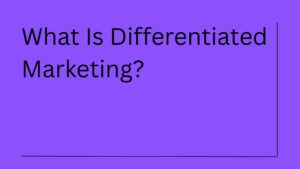Managing a project effectively is no small feat, especially when you’re juggling multiple tasks, teams, and timelines. Whether you’re coordinating a small internal project or overseeing a complex, multi-departmental initiative, project management tools can make or break your efforts. But with so many options out there, how do you know which tools will best meet your needs?
In this article, we’ll explore the top five project management tools available today, giving you a complete breakdown of their features, pricing, limitations, and user feedback. By the end, you’ll have a clear idea of which tool fits your project needs.
What Are Project Management Tools?
Project management tools are software applications designed to help you plan, execute, and monitor every aspect of your project. These tools streamline processes by offering features such as task scheduling, resource allocation, time tracking, document sharing, and team collaboration, all in one place. The ultimate goal is to help you deliver projects on time, within budget, and according to your goals.
What Makes the Best Project Management Tool?
The best project management tools go beyond just tracking tasks—they help you manage everything from start to finish. A top-notch tool should include the following key features:
- Ease of Use: You don’t want to spend more time figuring out the software than actually managing your project. Intuitive interfaces and simple workflows are a must.
- Comprehensive Task Management: Effective tools let you assign, prioritize, and track tasks, ensuring no deadlines are missed.
- Collaboration Features: Seamless communication, file sharing, and document collaboration are essential, especially if your team is remote.
- Time and Budget Tracking: The ability to monitor your budget and track time spent on tasks helps prevent project overruns.
- Customizability: Every project is different, so having software that you can tailor to your specific workflow is a huge advantage.
- Scalability: As your business grows, your tool should be able to scale with you, supporting additional users, features, and integrations.
With these factors in mind, let’s dive into our top five picks for project management tools. But before that, we’ve compiled a comparison table of the top five contenders, each offering unique features and functionalities to enhance project management and drive success. Check it out!
| Tool | Pricing | Key Features | Limitations | G2 Rating |
| Trello | Free to $10/month | Visual workflows, automation | Limited reporting, no time tracking | 4.4/5 |
| Asana | Free to $24.99/month | Task management, custom fields | Learning curve, limited free plan | 4.3/5 |
| Monday.com | Free to $16/month | Custom workflows, visual tracking | Expensive for larger teams | 4.6/5 |
| ClickUp | Free to $12/month | Goal tracking, custom dashboards | Steep learning curve, performance issues | 4.7/5 |
| Wrike | Free to $24.80/month | Advanced reporting, time tracking | Expensive, steep learning curve | 4.2/5 |
Top 5 Project Management Tools & Software
Wondering which project management software is right for you? We’ve gathered a list of the top contenders in the industry, each offering distinctive features and functionalities designed to enhance project management and boost your success.
1. Trello: Visualize your workflow with a customizable board
Trello has gained massive popularity for its simplicity and visual appeal, making project management intuitive for teams that prefer minimalistic, user-friendly designs. Initially designed as a digital Kanban board, Trello’s card-based system has made it a go-to tool for personal use, startups, and small teams. Its versatility also allows you to manage anything from simple to-do lists to more complex multi-step projects.
Since Trello’s interface revolves around boards and lists, it allows for clear categorization of tasks, making it a favorite for those who prefer visual planning. It’s ideal for teams that need to see their tasks flow from “To Do” to “In Progress” and finally to “Done.”
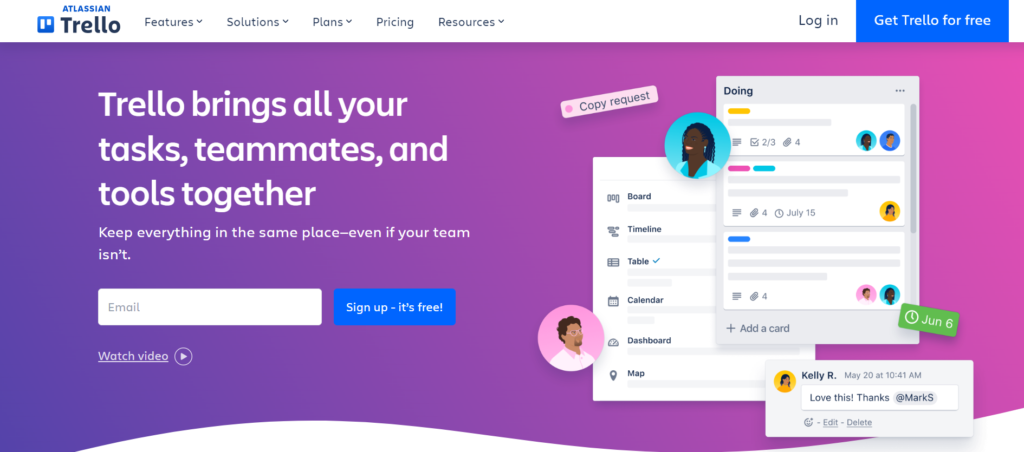
Product Features
- Customizable Kanban boards: Trello’s board-based system provides a clean and easy-to-understand view of tasks. You can move cards (tasks) across different lists (stages) and customize the workflow based on your team’s needs.
- Power-Ups: Extend Trello’s functionality through integrations with tools like Slack, Google Drive, Jira, and more. This allows Trello to be more than just a task management tool; it becomes a complete project management suite when fully optimized with Power-Ups.
- Card details: Each card represents a task and can hold detailed information, such as descriptions, due dates, attachments, comments, checklists, and more.
- Butler automation: Trello’s Butler feature lets you automate repetitive actions, such as moving cards when a task is completed or sending reminders based on due dates.
- Team collaboration: Teams can work together seamlessly on shared boards. Members can comment on cards, tag others, and assign tasks, improving team communication and accountability.
Limitations
While Trello excels at visual task management, it does lack depth in areas such as:
- Reporting: Trello’s reporting and analytics capabilities are minimal compared to more advanced tools. If your team needs in-depth performance reports or project forecasting, you may find Trello lacking.
- Scaling issues: As your projects grow in complexity, Trello can become cumbersome due to its limited hierarchical structure. Large projects with numerous tasks may result in cluttered boards that are hard to navigate.
- No native time tracking: You’ll need third-party integrations to track time spent on tasks, which can add to the complexity.
Pricing
Trello offers multiple pricing tiers:
- Free: Includes unlimited cards and up to 10 boards per team. Limited to one Power-Up per board.
- Standard: $5 per user/month. Includes unlimited boards, advanced checklists, and up to 250MB file attachments.
- Premium: $10 per user/month. Adds advanced features like timeline, calendar, map views, and priority support.
- Enterprise: Pricing depends on the organization’s size and needs. It includes added security, advanced permissions, and personalized onboarding.
Reviews and Ratings
- “Trello’s visual layout is fantastic for tracking tasks in an easy, digestible way. The flexibility of Power-Ups lets us integrate with all the other tools we need.” — G2 Review
- “It’s perfect for small, agile teams, but it’s not the best choice for larger projects with complex needs.” — G2 Review
2. Asana: Streamline projects with powerful collaboration tools
Asana is one of the most comprehensive project management tools available today, known for its powerful task and workflow management capabilities. Designed with scalability in mind, Asana offers flexibility for teams of all sizes, from startups to large enterprises. It excels at handling both personal tasks and team projects, making it one of the most versatile tools on the market.
What sets Asana apart is its ability to manage projects with multiple layers of complexity. Whether you’re tracking a product launch, planning a marketing campaign, or coordinating an entire team’s workload, Asana’s robust features help streamline the process. Its highly visual interface offers different project views, allowing you to organize tasks in a way that works best for you and your team.
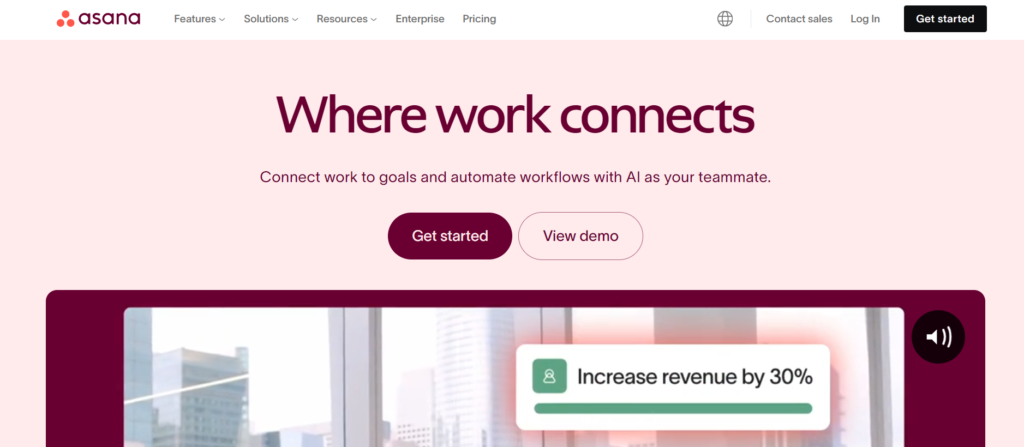
Product Features
- Multiple project views: Asana provides four primary views: List (traditional task management), Board (Kanban style), Timeline (Gantt chart view), and Calendar. This versatility allows teams to visualize their projects in different formats based on their needs.
- Task dependencies: One of Asana’s strongest features is task dependencies, which allow you to link tasks to one another, ensuring that one task cannot begin until another is completed.
- Custom fields: With custom fields, you can add unique attributes to tasks like priority level, project phase, or any other criteria important to your workflow.
- Workload management: Asana’s workload feature lets managers see how work is distributed across their team, ensuring no one is over or underworked.
- Project milestones: Set significant milestones throughout your project timeline to track key achievements and ensure projects stay on course.
- Advanced automation: You can set up custom automation rules that move tasks, assign team members, and trigger notifications based on various criteria, saving time on repetitive tasks.
Limitations
- Complexity for new users: While Asana offers powerful features, it can be overwhelming for new users. The extensive list of functionalities means that there is a learning curve, especially for users unfamiliar with project management software.
- Limited customization on the free plan: If you’re using Asana’s free plan, customization options are quite limited, and many of the advanced features (like task dependencies and milestones) are only available in paid plans.
Pricing
Asana offers tiered pricing options:
- Free: Basic task management for up to 15 users, with limited project views and no timeline or advanced features.
- Premium: $10.99 per user/month, which unlocks features like Timeline, task dependencies, custom fields, and advanced search.
- Business: $24.99 per user/month, including more advanced features such as workload management, goals, custom rules, and integrations with premium tools like Salesforce.
- Enterprise: Custom pricing for large teams with enhanced security, admin controls, and priority support.
Reviews and Ratings
- “Asana has made managing projects so much easier. The ability to track dependencies, set milestones, and visualize our work in different ways keeps everything organized.” — G2 Review
- “The learning curve is steep, but once you get the hang of it, the features are unparalleled.” — G2 Review
3. Monday.com: Transform teamwork with an intuitive platform
Monday.com markets itself as a “Work OS,” and rightfully so—this tool is far more than just a simple project management platform. It’s designed to manage every aspect of your work, allowing for full customization of workflows, project tracking, and team collaboration. The platform is incredibly versatile, suitable for managing both simple to-do lists and highly complex projects with intricate workflows.
One of the standout aspects of Monday.com is its ability to scale with your business. The tool offers a wide array of features that work across industries, from software development to marketing and human resources. Its highly visual interface, combined with a customizable workflow system, makes it one of the most adaptable project management tools on the market.
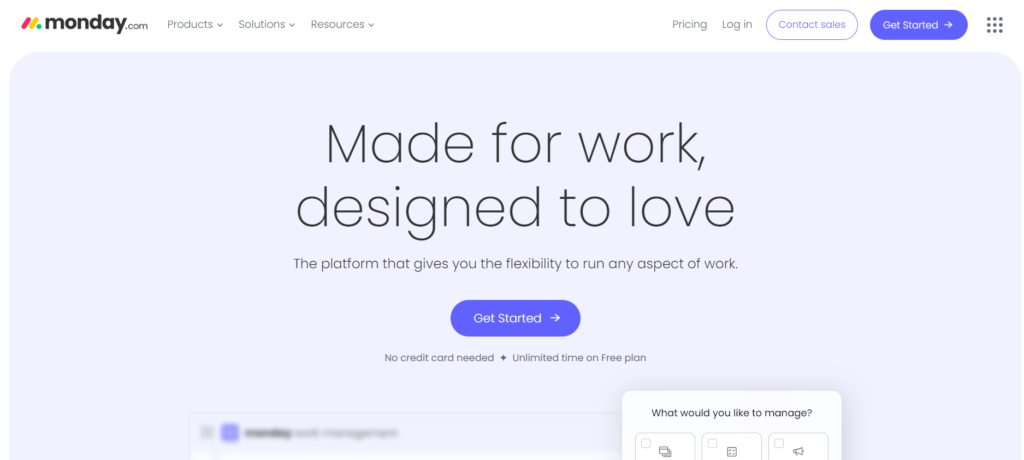
Product Features
- Custom workflows: Monday.com lets you create fully customizable workflows that fit the needs of your team or project. From simple Kanban boards to more complex, multi-layered processes, Monday.com offers the flexibility to manage your projects as you see fit.
- Time tracking: Track the time your team spends on tasks directly within the platform, ensuring that you have accurate records of project time.
- Templates: Monday.com offers a range of ready-made templates for various industries, including marketing, software development, HR, and sales. These templates help teams set up workflows quickly and start managing their projects right away.
- Integration with other tools: Connect Monday.com to other popular tools such as Slack, Zoom, Google Drive, and over 40 other apps, enabling seamless collaboration across different platforms.
- Automations: Automate routine tasks like task assignments, due date notifications, or status updates. This saves time and reduces the risk of human error.
Limitations
- Overly feature-rich for smaller teams: Monday.com offers an enormous number of features, which can be overwhelming for smaller teams or those with simpler project management needs.
- Pricing can add up: While Monday.com offers multiple pricing tiers, the cost can quickly escalate as you add more users or require more advanced features.
Pricing
Monday.com’s pricing is structured in multiple tiers:
- Individual: Free for up to 2 users, with limited features.
- Basic: $8 per user/month. Includes unlimited boards, over 200 templates, and 5GB of storage.
- Standard: $10 per user/month, adding timeline and calendar views, guest access, and integrations.
- Pro: $16 per user/month for advanced reporting, time tracking, automations, and private boards.
- Enterprise: Custom pricing for large organizations needing enterprise-grade security, advanced reporting, and dedicated support.
Reviews and Ratings
- “Monday.com’s flexibility is unmatched. We can manage our marketing campaigns, software development projects, and even HR processes all in one place.” — G2 Review
- “The interface is incredibly user-friendly, but the cost can become an issue if you’re managing a large team or need advanced features.” — G2 Review
4. ClickUp: Robust tracking and reporting for software teams
ClickUp has positioned itself as an all-in-one project management solution designed to replace multiple tools and integrate workflows into one platform. It is highly customizable and boasts an impressive list of features that cater to virtually every project management need. From task management to goal setting, time tracking, and document collaboration, ClickUp offers an incredibly diverse set of features.
What makes ClickUp unique is its mission to become the ultimate productivity platform, combining project management, team collaboration, goal tracking, and communication all in one place. It’s suitable for teams of all sizes, from freelancers to large enterprises, and is known for its highly adaptable nature.
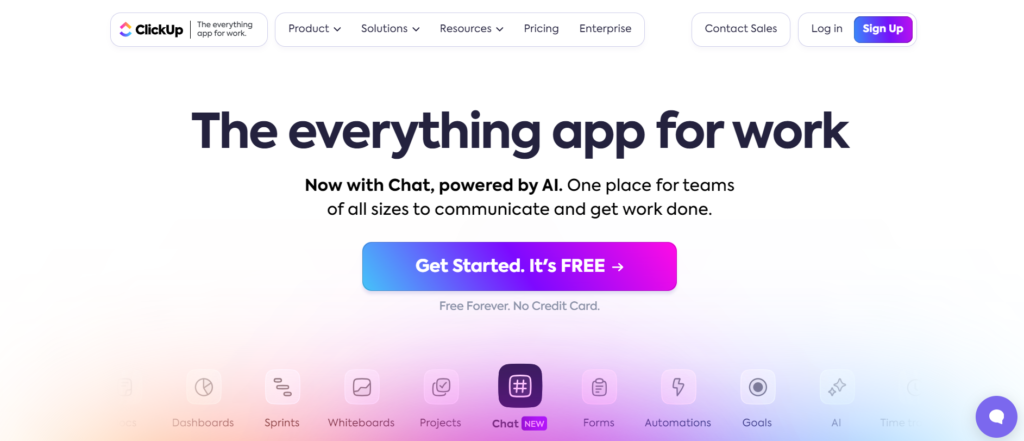
Product Features
- Multiple views: ClickUp offers a wide range of project views including List, Board, Calendar, Timeline, and Gantt charts. You can toggle between these views, allowing team members to manage tasks in the format that suits them best.
- Task relationships: Create dependencies, sub-tasks, and checklists within tasks, ensuring that everything is tracked from start to finish.
- Goal tracking: ClickUp lets you define goals and track progress at a granular level, making it ideal for teams focused on long-term objectives.
- Custom dashboards: With ClickUp’s customizable dashboards, you can create a high-level overview of your project, showing key metrics, performance insights, and workload distribution.
- Team collaboration: In addition to task management, ClickUp provides features like real-time document collaboration, in-app chat, and whiteboards for brainstorming sessions.
Limitations
- Steep learning curve: ClickUp’s wide array of features can be overwhelming for new users. The customization options, while powerful, require some time to fully understand and configure.
- Performance issues: Some users report performance slowdowns when handling larger projects or using more complex views like Gantt charts.
Pricing
ClickUp offers flexible pricing:
- Free Forever: Includes unlimited tasks, members, and two-factor authentication.
- Unlimited: $5 per user/month, which adds unlimited integrations, dashboards, and custom fields.
- Business: $12 per user/month. Adds advanced features like timelines, goal tracking, and time tracking.
- Enterprise: Custom pricing for large teams, including advanced permissions, single sign-on (SSO), and priority support.
Reviews and Ratings
- “ClickUp is a game-changer for us. We used to switch between several tools, but now everything is integrated into one platform.” — G2 Review
- “The learning curve is steep, but once you’re up and running, the platform offers more features than almost any other tool.” — G2 Review
5. Wrike: All-in-one productivity platform that brings all together
Wrike is a powerful project management platform known for its robust reporting and scalability. With a focus on project planning, team collaboration, and performance tracking, Wrike is tailored for teams that need detailed insights and control over their projects. The tool offers a structured approach to project management, making it a favorite among teams handling complex projects in industries like marketing, engineering, and product development.
Wrike’s comprehensive set of features includes advanced reporting, time tracking, and resource management. It’s designed to help organizations streamline their processes while ensuring accountability and transparency at every stage of a project.
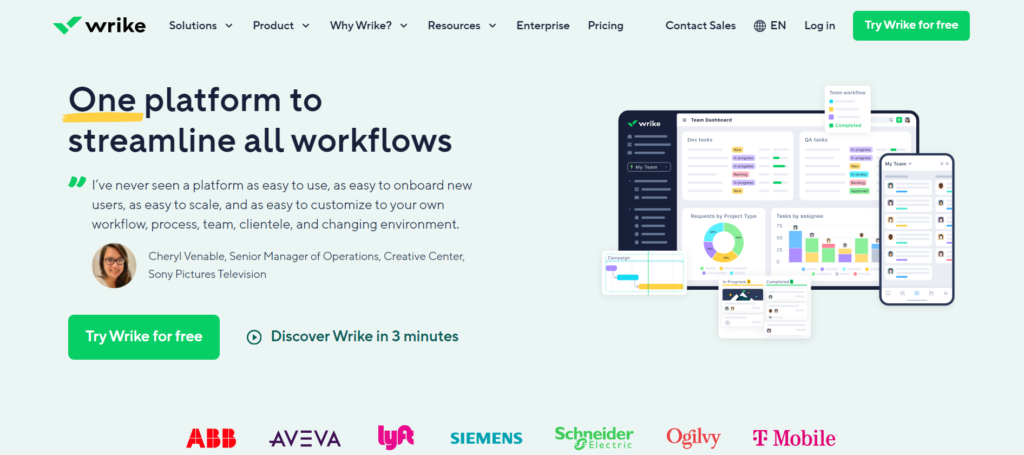
Product Features
- Customizable dashboards: Wrike provides personalized dashboards for each team member, allowing them to monitor tasks, deadlines, and workload in real-time.
- Advanced reporting: Wrike’s robust reporting tools allow you to generate custom reports on team performance, project progress, and more.
- Time tracking: Teams can track time spent on tasks and projects directly in Wrike, providing valuable insights into productivity and resource allocation.
- Project templates: Wrike offers pre-built templates for a wide range of industries, helping teams get up and running quickly.
- Collaborative proofing: For creative teams, Wrike’s proofing tool allows team members to review, approve, and comment on files, making the approval process faster and more streamlined.
Limitations
- High cost: Wrike’s pricing can be prohibitive for smaller teams, especially if you require advanced features like time tracking or custom workflows.
- Steep learning curve: Wrike’s extensive feature set means that it can take some time for teams to fully adopt the platform and integrate it into their daily workflows.
Pricing
Wrike’s pricing tiers are:
- Free: Basic task management for up to 5 users, with limited features.
- Professional: $9.80 per user/month, includes Gantt charts, time tracking, and basic integrations.
- Business: $24.80 per user/month. Adds advanced features like custom workflows, real-time reporting, and more integrations.
- Enterprise: Custom pricing for larger teams that require additional security, advanced analytics, and priority support.
Reviews and Ratings
- “Wrike’s reporting features have helped us stay on top of our project goals and deadlines. It’s a must-have tool for large projects.” — G2 Review
- “The interface is robust, but it can feel overwhelming at first. Definitely a tool for teams that need detailed project management.” — G2 Review
Conclusion
Choosing the right project management tool can revolutionize how you manage projects, teams, and workflows. The tools we’ve listed—Trello, Asana, Monday.com, ClickUp, and Wrike—each offer unique strengths and are suitable for different project management needs. Whether you’re looking for something simple and visual like Trello or a robust platform with advanced reporting like Wrike, you’ll find a tool that fits your requirements.
Now that you’ve explored the top options, it’s time to choose the tool that will help you streamline your projects, boost collaboration, and hit your deadlines. Happy project managing!




